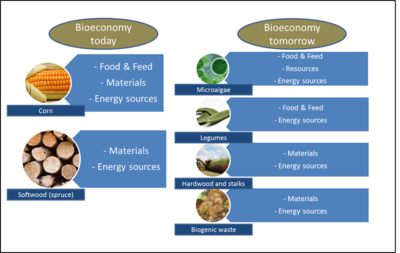Bioeconomy
Biomass is gaining economic significance not only for the production of food and feed but also for the production of platform chemicals, bio-based products and energy due to the limited availability of fossil resources.
Therefore economic sectors that have so far relied on fossil resources are now finding themselves at a shift towards a bio-based economy with biomass as a renewable raw material. Established technologies often use only certain biomass components to develop higher value products. In contrast, bioeconomy concepts attempt to use all biomass components in coupled or cascade use by resource-friendly means.
If the sustainably use of water and soil, the protection of biodiversity, and compliance with social factors are assured, a bioeconomy could significantly contribute to climate and resource protection and global food security.
According to the definition of the German Bioeconomy Council: "Bioeconomy is the sustainable and innovative use of renewable resources to provide food, feed and industrial products with enhanced properties. Besides economic growth the bioeconomy aims for food security, climate protection and conservation of scarce natural resources."
Many countries worldwide have developed their own bioeconomy strategies for the future. In Germany the Bioeconomy Council was implemented in 2009 as an independent advisory board to the government. The council openly communicates with society by publishing recommendations and statements. In 2010 the National Bioeconomy Research Strategy 2030 was published and in 2013 the National Policy Strategy.
The European Commission published a new bioeconomy strategy in 2018 and many countries and regions worldwide are establishing their Bioeconomy strategy to prepare for the future.
Baden-Württemberg had been implementing a research strategy since 2014 and presents a new regional strategy "Sustainable Bioeconomy in Baden-Württemberg" in 2019 as policy strategy to define the route for a sustainable, knowlegde based Bioeconomy in Baden-Württemberg.

